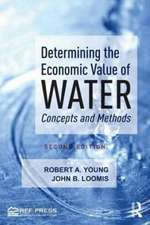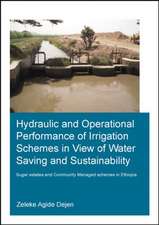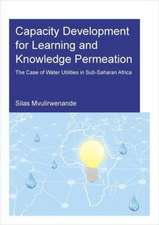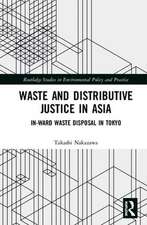Drought: Research and Science-Policy Interfacing
Editat de Joaquin Andreu, Abel Solera, Javier Paredes-Arquiola, David Haro-Monteagudo, Henny van Lanenen Limba Engleză Hardback – 12 feb 2015
Usually, drought does not directly cause fatalities, but a wide range of socio-economic and environmental effects may occur, and, depending on the region, water-and food-related diseases and casualties can be triggered. Europe has regularly been hit hard by drought (e.g. recently Russia), and large portions of USA, Mexico, Brazil, China, India, Central Asia, South Africa, the Great Horn of Africa, or Australia, have been affected by drought. So globally, drought affects more regions, and more people, than other natural hazards.
Additionally, climate change projections for many areas indicate that droughts are likely to become more frequent and more severe due to the increased variability of precipitation and temperature, tied in some cases to decreased average precipitation and increased average temperature. Hence, there is an urgent need to improve drought preparedness through measures that reduce vulnerability to drought and the risks they pose, in particular considering the uncertain future.
Drought. Research and Science Policy Interfacing includes contributions to the International Conference on DROUGHT: Research and Science-Policy Interfacing (Valencia, Spain, 10-13 March 2015), the final event of the EU FP7 research project DROUGHT-R&SPI (Fostering European Drought Research and Science-Policy Interfacing). The book aims to foster development of drought policies and plans to reduce risk and vulnerability, and to enhance preparedness and resilience.
The book addresses the following topics : (1) past, present and future of droughts (natural hazards, identification and characterization, impacts); (2) indicators, monitoring and forecasting (including early warning systems), risk and vulnerability assessment and reduction at different scales, and (3) preparedness and mitigation options (risk and vulnerability perception, water management and governance under drought conditions, design and implementation of drought policies and plans from the local to the regional, national and international levels, research Interfaces with drought policies).
Drought. Research and Science Policy Interfacing will be of interest to researchers and professionals in those fields related to drought, such as climatology, meteorology, hydrology, agronomy, ecology, water economy, and water management, as well as to policy makers involved in drought preparedness and mitigation strategies at local, regional, national and international levels.
Preț: 1053.58 lei
Preț vechi: 1448.39 lei
-27% Nou
Puncte Express: 1580
Preț estimativ în valută:
201.63€ • 209.73$ • 166.46£
201.63€ • 209.73$ • 166.46£
Carte tipărită la comandă
Livrare economică 14-28 aprilie
Preluare comenzi: 021 569.72.76
Specificații
ISBN-13: 9781138027794
ISBN-10: 1138027790
Pagini: 530
Dimensiuni: 174 x 246 x 36 mm
Greutate: 1.07 kg
Ediția:1
Editura: CRC Press
Colecția CRC Press
ISBN-10: 1138027790
Pagini: 530
Dimensiuni: 174 x 246 x 36 mm
Greutate: 1.07 kg
Ediția:1
Editura: CRC Press
Colecția CRC Press
Public țintă
Postgraduate and ProfessionalNotă biografică
Joaquin Andreu, Abel Solera, Javier Paredes-Arquiola, David Haro-Monteagudo, Henny van Lanen
Cuprins
Foreword, Preface, Organization, Introduction, Fostering drought research and science-policy interfacing: Achievements of the DROUGHT-R&SPI project, Past, present and future of droughts, Drought as a natural hazard, Characteristics and drivers of drought in Europe—a summary of the DROUGHT-R&SPI project, European historic droughts beyond the modern instrumental records 16th–20th centuries, A comprehensive drought climatology for Europe (1950–2013), Assessment of past and future drought impacts, Impact of drought on the inhabitants of the Cuvelai watershed: A qualitative exploration, Rainy season pattern and impacts on agriculture and water resources in Northeastern Brazil, Modelling of last hypothesis of climate change impacts on water resources in Sierra de las Cabras aquifer (Southern Spain), Drought effects on rainfed agriculture using standardized indices: A case study in SE Spain, Ex-post evaluation of the socio-economic impacts of drought in some areas in Europe, Analysis of Guadalquivir droughts 2004–2012 based on SEEA-W tables, Multi-scalar drought and its impact on crop yield in the Republic of Moldova, Climate change and the increase of wildfire risk in the Upper Jucar River Basin, Spain, Integration of climate time series and MODIS data as an analysis tool for forest drought detection, Comparing low moisture availability and relative crop yields on the pan-European scale using the FAO water production function, Impact of meteorological drought on crop yield on pan-European scale, 1979–2009, Temperature extremes, moisture deficiency and their impacts on dryland agriculture in Gujarat, India, Analysis of drought episode in Borno State of North-Eastern Nigeria, Drought identification and characterization, Using standardized precipitation and runoff indices for the identification of extraordinary drought events in Chile, Application of the Standardized Precipitation Index (SPI) in Hawke’s Bay, New Zealand, On the use of modelled soil moisture for drought assessment over Europe, Improving operational drought definitions—taking them to basin scale, Evaluation of drought occurrence in springs yields of the Nízke Tatry Mts., Chronology of drought termination for long records in the Thames catchment, Variability and patterns of drought characteristics based on SPEI in the Huang-Huai-Hai Plain between 1981 and 2010, Identification and frequency analysis of drought events in the Blanice river catchment (Czech Republic), Climate change and drought in the South of Carpathian basin and transboundary implications, Climate change impact on water resources and droughts of AR5 scenarios in the Jucar River, Spain, Drought indicators, monitoring and forecasting, Indicators and monitoring, Drought in South-Eastern Europe: Monitoring and management, The U.S. Drought Monitor: Evolution and recent achievements, Drought monitoring in a transboundary river basin in North America, Assessment and comparison of drought monitoring using hydrological and meteorological indices—Case study: The ZayandehRud water reservoir, Iran, The drought indicator system in the Júcar River Basin Authority, A simple method to estimate irrigation date for soil moisture modeling and agricultural drought monitoring in irrigated regions, A preliminary assessment of meteorological and hydrological drought indicators for application to catchments across the UK, An approach to monitoring drought events and food security conditions, Evaluation of ensemble SPI forecasts for Ceará, Northeastern Brazil, Water scarcity cost as a drought indicator through hydroeconomic modelling—application to the Jucar River Basin, Early warning systems, Improved rainfall-runoff modelling tools for low-flow forecasting: Application to French catchments, Possibilities on drought forecasting in Croatia, IMPETUS: Improving predictions of drought for user decision-making, Developing a framework for drought forecasting and warning: Results of the DEWFORA project, Enhancing drought Monitoring and Early Warning by linking indicators to impacts, El Niño/La Niña events as a tool for regional drought monitoring in Southern South America, Seasonal hydrologic forecasting under drought conditions in the Upper Jucar River Basin, Spain, Seasonal forecasts of hydrological drought in the Limpopo basin: Getting the most out of a bouquet of methods, Climate seasonal forecast and derived indexes for droughts in Ceará, Brazil, Use of seasonal climate predictions in the water sector—preliminary results from the EUPORIAS project, Drought risk and vulnerability assessment, An impact perspective on pan-European drought sensitivity, Drought vulnerability assessment for different hydrological conditions based on Standardized Runoff Index and Flow Duration Curve in Lithuania, Exploring situations of vulnerability to drought from a sectorial perspective: A starting point for regional assessments, The dynamics of vulnerability to drought from an impact perspective, Drought vulnerability assessment and potential adaptation options in the Aegean islands, Vulnerability to drought: Mapping underlying factors across Europe, Drought preparedness and mitigation options, Drought risk and vulnerability perception, Drought and agricultural insurance in Spain, Hydrological reliability assessment of water management solution of reservoir storage capacity in conditions of uncertainty, Water management and governance under drought conditions, From drought planning to drought management: Administrative and follow-up tasks, Securing drinking water supply during extreme drought — learnings from South Australia, Regional governance assessment for drought adaptation in North-West Europe: Case study results from the analysis with a Governance Assessment Tool in the DROP-project, Conjunctive use of surface and ground waters during drought and climate change assumptions — Duero River Basin, Spain, Improving resilience to drought of the Apulian water resources system—a hydroeconomic model, Definition of optimal drought-oriented reservoir management policies combining stochastic programming and fuzzy logic, The debate on sustainable water management: Evidence from drought in the Jucar Basin, Applying the WARGI DSS to optimise water supply systems under drought conditions: Analysis of the South-Sardinia water system, Decision support system for drought management in a transboundary context, Managing of the agriculture water consumption to meet the environmental flows of the Lake Urmia during the droughts, Development and implementation of drought policies and plans from the local to the regional, national and international levels, Towards policy recommendations for future drought risk reduction, The Australian experience in managing through protracted drought, Implementing the national drought policy in Mexico: Challenges and strategies for a sound water resources management, Integrated water resources management strategy to mitigate drought impacts in Mexico, Drought and water scarcity in Iran: How to cope with and prepare for it?, Water markets in Spain: A tool for drought mitigation, Program of preventive and mitigation drought measures in the Rio Balsas Basin Council, Mexico, Research and science interfaces with drought policies, European experience with science-policy interfacing to cope with drought, Author index
Descriere
This book aims to foster development of drought policies and plans to reduce risk and vulnerability, and to enhance preparedness and resilience, and will be of interest to researchers and professionals in those fields related to drought, such as climatology, meteorology, hydrology, agronomy, ecology, water economy, and water management, and to policy makers involved in drought preparedness and mitigation strategies at local, regional, national and international levels.











